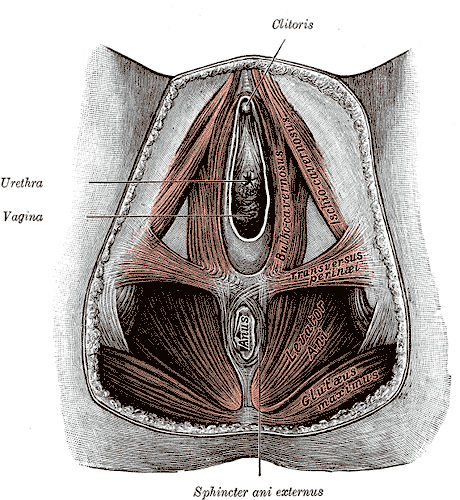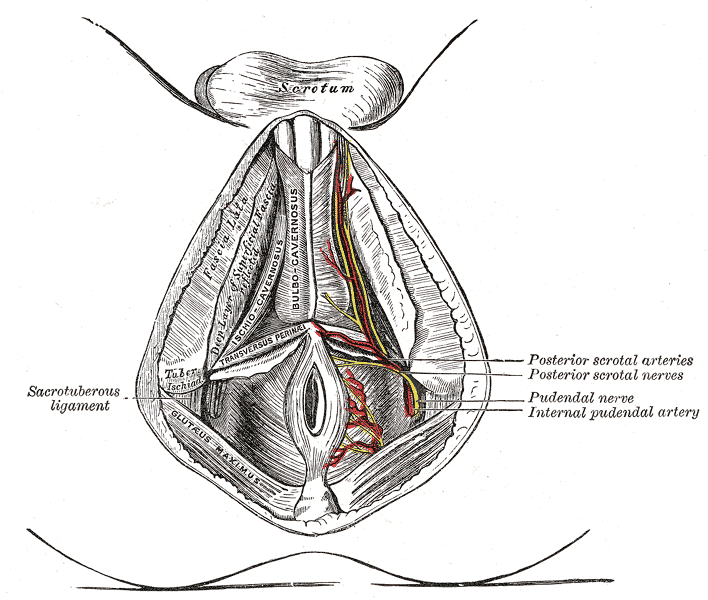[2]
Oelhafen K, Shayota BJ, Muhleman M, Klaassen Z, Tubbs RS, Loukas M. Benjamin Alcock (1801-?) and his canal. Clinical anatomy (New York, N.Y.). 2013 Sep:26(6):662-6. doi: 10.1002/ca.22080. Epub 2012 Apr 9
[PubMed PMID: 22488487]
[5]
Benson JT, Griffis K. Pudendal neuralgia, a severe pain syndrome. American journal of obstetrics and gynecology. 2005 May:192(5):1663-8
[PubMed PMID: 15902174]
[6]
Nehme-Schuster H, Youssef C, Roy C, Brettes JP, Martin T, Pasquali JL, Korganow AS. Alcock's canal syndrome revealing endometriosis. Lancet (London, England). 2005 Oct 1:366(9492):1238
[PubMed PMID: 16198773]
[7]
Snooks SJ, Swash M, Henry MM, Setchell M. Risk factors in childbirth causing damage to the pelvic floor innervation. The British journal of surgery. 1985 Sep:72 Suppl():S15-7
[PubMed PMID: 4041752]
[9]
Mongelli F, Lucchelli M, La Regina D, Christoforidis D, Saporito A, Vannelli A, Di Giuseppe M. Ultrasound-Guided Pudendal Nerve Block in Patients Undergoing Open Hemorrhoidectomy: A Post-Hoc Cost-Effectiveness Analysis from a Double-Blind Randomized Controlled Trial. ClinicoEconomics and outcomes research : CEOR. 2021:13():299-306. doi: 10.2147/CEOR.S306138. Epub 2021 Apr 28
[PubMed PMID: 33953578]
Level 1 (high-level) evidence
[10]
Abdi S, Shenouda P, Patel N, Saini B, Bharat Y, Calvillo O. A novel technique for pudendal nerve block. Pain physician. 2004 Jul:7(3):319-22
[PubMed PMID: 16858468]
[11]
Levesque A, Bautrant E, Quistrebert V, Valancogne G, Riant T, Beer Gabel M, Leroi AM, Jottard K, Bruyninx L, Amarenco G, Quintas L, Picard P, Vancaillie T, Leveque C, Mohy F, Rioult B, Ploteau S, Labat JJ, Guinet-Lacoste A, Quinio B, Cosson M, Haddad R, Deffieux X, Perrouin-Verbe MA, Garreau C, Robert R. Recommendations on the management of pudendal nerve entrapment syndrome: A formalised expert consensus. European journal of pain (London, England). 2022 Jan:26(1):7-17. doi: 10.1002/ejp.1861. Epub 2021 Oct 13
[PubMed PMID: 34643963]
Level 3 (low-level) evidence
[12]
Popeney C, Ansell V, Renney K. Pudendal entrapment as an etiology of chronic perineal pain: Diagnosis and treatment. Neurourology and urodynamics. 2007:26(6):820-7
[PubMed PMID: 17480033]
[13]
Silbert PL, Dunne JW, Edis RH, Stewart-Wynne EG. Bicycling induced pudendal nerve pressure neuropathy. Clinical and experimental neurology. 1991:28():191-6
[PubMed PMID: 1821826]
[14]
Luesma MJ, Galé I, Fernando J. Diagnostic and therapeutic algorithm for pudendal nerve entrapment syndrome. Medicina clinica. 2021 Jul 23:157(2):71-78. doi: 10.1016/j.medcli.2021.02.012. Epub 2021 Apr 6
[PubMed PMID: 33836860]
[15]
Vancaillie T, Eggermont J, Armstrong G, Jarvis S, Liu J, Beg N. Response to pudendal nerve block in women with pudendal neuralgia. Pain medicine (Malden, Mass.). 2012 Apr:13(4):596-603. doi: 10.1111/j.1526-4637.2012.01343.x. Epub 2012 Mar 5
[PubMed PMID: 22390343]
[16]
Choi SS, Lee PB, Kim YC, Kim HJ, Lee SC. C-arm-guided pudendal nerve block: a new technique. International journal of clinical practice. 2006 May:60(5):553-6
[PubMed PMID: 16700853]
[17]
Kim SH, Song SG, Paek OJ, Lee HJ, Park DH, Lee JK. Nerve-stimulator-guided pudendal nerve block by pararectal approach. Colorectal disease : the official journal of the Association of Coloproctology of Great Britain and Ireland. 2012 May:14(5):611-5. doi: 10.1111/j.1463-1318.2011.02720.x. Epub
[PubMed PMID: 21752174]
[18]
Ricci P, Wash A. Pudendal nerve block by transgluteal way guided by computed tomography in a woman with refractory pudendal neuralgia expressed like chronic perineal and pelvic pain. Archivos espanoles de urologia. 2014 Jul:67(6):565-71
[PubMed PMID: 25048589]
[19]
Ploteau S, Perrouin-Verbe MA, Labat JJ, Riant T, Levesque A, Robert R. Anatomical Variants of the Pudendal Nerve Observed during a Transgluteal Surgical Approach in a Population of Patients with Pudendal Neuralgia. Pain physician. 2017 Jan-Feb:20(1):E137-E143
[PubMed PMID: 28072805]
[20]
Zador G, Lindmark G, Nilsson BA. Pudendal block in normal vaginal deliveries. Clinical efficacy, lidocaine concentrations in maternal and foetal blood, foetal and maternal acid-base values and influence on uterine activity. Acta obstetricia et gynecologica Scandinavica. Supplement. 1974:(34):51-64
[PubMed PMID: 4531162]
[21]
Kalava A, Pribish AM, Wiegand LR. Pudendal nerve blocks in men undergoing urethroplasty: a case series. Romanian journal of anaesthesia and intensive care. 2017 Oct:24(2):159-162. doi: 10.21454/rjaic.7518.242.klv. Epub
[PubMed PMID: 29090268]
Level 2 (mid-level) evidence
[23]
Schierup L, Schmidt JF, Torp Jensen A, Rye BA. Pudendal block in vaginal deliveries. Mepivacaine with and without epinephrine. Acta obstetricia et gynecologica Scandinavica. 1988:67(3):195-7
[PubMed PMID: 3051873]
[24]
Antolak S Jr, Antolak C, Lendway L. Measuring the Quality of Pudendal Nerve Perineural Injections. Pain physician. 2016 May:19(4):299-306
[PubMed PMID: 27228517]
Level 2 (mid-level) evidence
[25]
Ford JM, Owen DJ, Coughlin LB, Byrd LM. A critique of current practice of transvaginal pudendal nerve blocks: a prospective audit of understanding and clinical practice. Journal of obstetrics and gynaecology : the journal of the Institute of Obstetrics and Gynaecology. 2013 Jul:33(5):463-5. doi: 10.3109/01443615.2013.771155. Epub
[PubMed PMID: 23815197]
Level 3 (low-level) evidence
[26]
Anderson D. Pudendal nerve block for vaginal birth. Journal of midwifery & women's health. 2014 Nov-Dec:59(6):651-659. doi: 10.1111/jmwh.12222. Epub 2014 Oct 7
[PubMed PMID: 25294258]
[27]
Saloheimo AM. Paracervical block anesthesia in labor. Acta obstetricia et gynecologica Scandinavica. 1968:47(S5):1-21
[PubMed PMID: 5704597]
[28]
Aksoy H, Aksoy U, Ozyurt S, Ozoglu N, Acmaz G, Aydın T, İdem Karadağ Ö, Tayyar AT. Comparison of lidocaine spray and paracervical block application for pain relief during first-trimester surgical abortion: A randomised, double-blind, placebo-controlled trial. Journal of obstetrics and gynaecology : the journal of the Institute of Obstetrics and Gynaecology. 2016 Jul:36(5):649-53. doi: 10.3109/01443615.2016.1148681. Epub 2016 Feb 29
[PubMed PMID: 26926158]
Level 1 (high-level) evidence
[29]
Chanrachakul B, Likittanasombut P, O-Prasertsawat P, Herabutya Y. Lidocaine versus plain saline for pain relief in fractional curettage: a randomized controlled trial. Obstetrics and gynecology. 2001 Oct:98(4):592-5
[PubMed PMID: 11576573]
Level 1 (high-level) evidence
[31]
NYIRJESY I, HAWKS BL, HEBERT JE, HOPWOOD HG Jr, FALLS HC. HAZARDS OF THE USE OF PARACERVICAL BLOCK ANESTHESIA IN OBSTETRICS. American journal of obstetrics and gynecology. 1963 Sep 15:87():231-5
[PubMed PMID: 14077620]
[32]
Palomäki O, Huhtala H, Kirkinen P. A comparative study of the safety of 0.25% levobupivacaine and 0.25% racemic bupivacaine for paracervical block in the first stage of labor. Acta obstetricia et gynecologica Scandinavica. 2005 Oct:84(10):956-61
[PubMed PMID: 16167911]
Level 2 (mid-level) evidence
[33]
Basol G, Kale A, Gurbuz H, Gundogdu EC, Baydilli KN, Usta T. Transvaginal pudendal nerve blocks in patients with pudendal neuralgia: 2-year follow-up results. Archives of gynecology and obstetrics. 2022 Oct:306(4):1107-1116. doi: 10.1007/s00404-022-06621-1. Epub 2022 May 28
[PubMed PMID: 35633372]
[34]
Naja MZ, Al-Tannir MA, Maaliki H, El-Rajab M, Ziade MF, Zeidan A. Nerve-stimulator-guided repeated pudendal nerve block for treatment of pudendal neuralgia. European journal of anaesthesiology. 2006 May:23(5):442-4
[PubMed PMID: 16573866]




